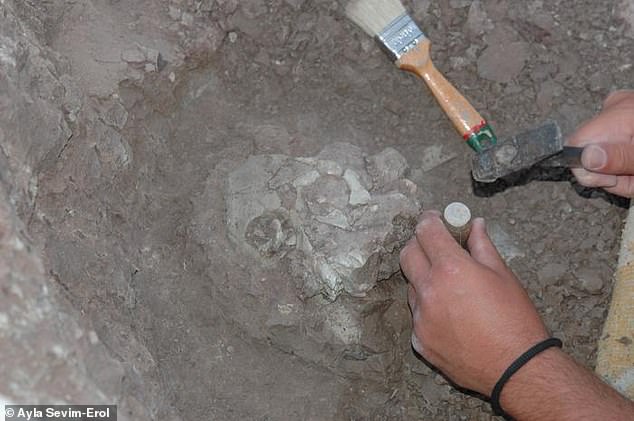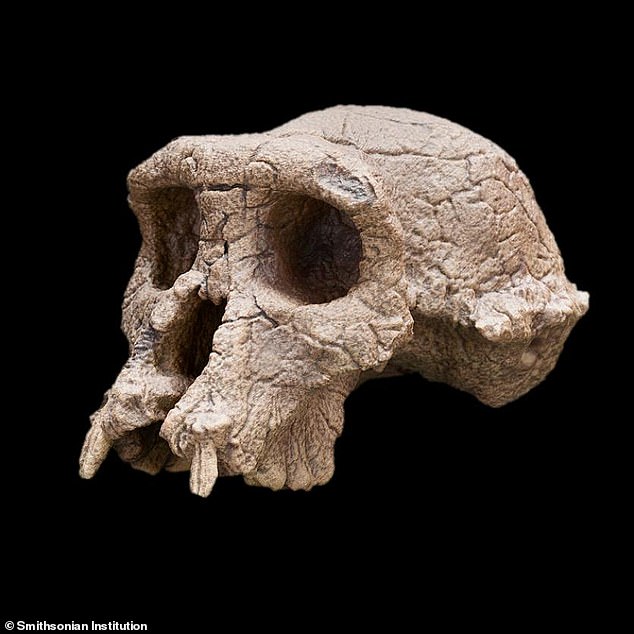Skull of 8.7-million-year-old ape found in Turkey suggests our ancestors evolved in Europe and NOT Africa, study claims
It was long believed that our ancestors came exclusively from Africa, but the skull of an 8.7 million-year-old monkey found in Turkey suggests that they first appeared in Europe.
The skull is a newly identified ape called Anadoluvius turkae and is said to be the first known radiation from early hominids — a group that also includes African apes and humans.
Scientists claimed the skull proves that hominies evolved in western and central Europe and spent more than five million years there before migrating to Africa from the Mediterranean.
The widely held belief that our ancestors evolved in Africa stems largely from the skull of Sahelanthropus tchadensis, believed to be the oldest known species in the human family tree; he lived until seven million years ago.
The skull was recovered from the Çorakyerler fossil site near Cankiri, a city in Turkey, about 140 kilometers north of Ankara. It predates its find in Africa by more than five million years

It was long believed that ancient human ancestors originated in Africa. Remains have been found that date from about seven million years ago
The new research is based on an analysis of a significantly well-preserved partial skull discovered at the site in 2015, which includes most of the facial structure and anterior portion of the braincase.
The findings are described in a study published in Communications Biology, co-authored by an international team of researchers led by Professor David Begun at the University of Toronto (U of T) and Professor Ayla Sevim Erol at Ankara University.
The skull was recovered from the Çorakyerler fossil site near Cankiri, a city in Turkey, about 140 kilometers north of Ankara.
Researchers said Anadoluvius weighed 110 to 130 pounds, lived in a dry forest environment, and probably spent a lot of time on the ground.
Begun said, “The face is mostly complete after applying mirror images. The new part is the forehead, with the bone preserved up to approximately the crown of the skull.
“Previously described fossils don’t have that much brain tissue.”

Researchers said Anadoluvius weighed 110 to 130 pounds, lived in a dry forest environment and likely spent a lot of time on the ground
The researchers also suggested that Anadoluvius and other fossil apes from nearby areas, such as Ouranopithecus in Greece and Turkey and Graecopithecus in Bulgaria, formed a group of early hominins.
This points to the idea that the earliest hominids appeared in Europe and the eastern Mediterranean.
Specifically, the ancient Balkan and Anatolian monkeys evolved from ancestors in Western and Central Europe.
“With the more extensive data, the study provides evidence that these other apes were also hominids, meaning it is more likely that the entire group evolved and diversified in Europe, rather than the alternative scenario in which individual branches of apes migrated to Europe independently.” moved. Europa disappeared from Africa over millions of years and then went extinct without a hitch,” the researchers shared in a statement.
Begon admitted that there is no evidence for the latter.
“It remains a favorite proposition among those who do not accept the European origin hypothesis,” he said.

The popular theory stems from the skull of Sahelanthropus tchadensis, found in Chad, believed to be the oldest known species in the human family tree; he lived until seven million years ago.
‘These findings contradict the long-held view that African apes and humans evolved exclusively in Africa.
Although early hominin remains are abundant in Europe and Anatolia, they were completely absent from Africa until the first hominids appeared there about seven million years ago.
“This new evidence supports the hypothesis that hominids originated in Europe and spread to Africa along with many other mammals between nine and seven million years ago, although it does not definitively prove this.
“For that, we need to find more fossils from Europe and Africa between eight and seven million years old to make a definitive link between the two groups.”
